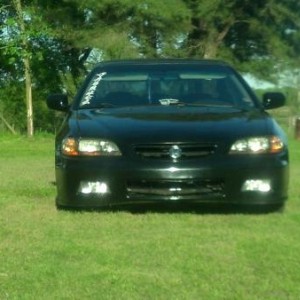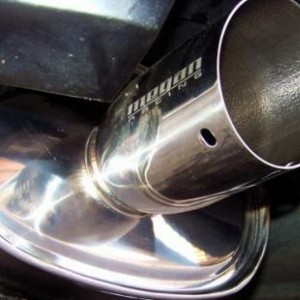vorin
Well-Known Member
Tools Required:
Soldering Iron
Solder
Electrical Tape
Flat-head Screwdriver
Wire Strippers
LED (your choice of color) with appropriate resistor
Small Phillips-head screwdriver (Jeweler's preferred)
Recommended Tools:
Extra Tip for Soldering Iron (used to melt plastic)
Outline:
1.Clock Removal
2.Clock Dissection
3.LED Installation
4.Results
Part 1:
Use your electrician's tape to cover the metal tip of your flat-head screwdriver (or use your own special tool.)
Insert the tip underneath the clock assembly - in the crease below the three buttons
Apply some pressure in and pry up (handle down, tip up) in order to pop the bottom out from its clips.
At this point, you should be able to put the screwdriver down, and loosen the rest of the clock housing from its top clips.
Now, Unplug the two sets of wires from the clock assy. (1. the hazard button wires, 2. the clock wires) Each of these sets has a spring clip holding them in place.
Now the clock should be free from the car, and now you can begin working indoors.
Part 2:
In order to free up some space, you can remove the hazard button by pushing it toward the face of the assembly.
You should notice a white plastic cover on the back of the clock which is held in by 4 clips.
Gently use your flat-head screwdriver (you can take off the tape) to unclip the back and reveal the circuitry
Now, use your small Phillips-head to undo the four screws holding the board in. - Make sure to get all 4, i almost broke mine when i was trying to pry it up when i only removed 3
Now, the circuit board should come out easily, and you'll see the board, the glass, the blue filter, the LCD, and the clear plastic lens.
Set the white plastic cover and the circuit board aside.
Part 3:
Heat up your Soldering Iron with your extra tip.
Use it to melt a place in the side for the LED to sit
Then, allow it to cool off, so you can use your normal soldering tip (or clean off your first tip)


Now, Solder your resistor to the positive end of your LED (the longer leg)

Now, I decided you bend the negative lead and feed it inside the hole, and run the positive lead around the outside.
Solder the positive and negative (respectively) leads to the appropriate contact on the board.

that was my first attempt (not very good)

Now, without putting anything back together, test out your LED by plugging in your cable to the back of the circuit board (the spring clip of the connector faces up) - when you are testing it, make sure your key is turned to the ON position. (i thought i failed miserably, and gave up. I was "testing" it by only turning on the driving lights without having the key in the ignition. but then i was driving around and noticed it was lit! it's a good feeling)
If everything tests fine, reassemble your whole clock and put it back in your car.
Part 4:

for comparison


Soldering Iron
Solder
Electrical Tape
Flat-head Screwdriver
Wire Strippers
LED (your choice of color) with appropriate resistor
Small Phillips-head screwdriver (Jeweler's preferred)
Recommended Tools:
Extra Tip for Soldering Iron (used to melt plastic)
Outline:
1.Clock Removal
2.Clock Dissection
3.LED Installation
4.Results
Part 1:
Use your electrician's tape to cover the metal tip of your flat-head screwdriver (or use your own special tool.)
Insert the tip underneath the clock assembly - in the crease below the three buttons
Apply some pressure in and pry up (handle down, tip up) in order to pop the bottom out from its clips.
At this point, you should be able to put the screwdriver down, and loosen the rest of the clock housing from its top clips.
Now, Unplug the two sets of wires from the clock assy. (1. the hazard button wires, 2. the clock wires) Each of these sets has a spring clip holding them in place.
Now the clock should be free from the car, and now you can begin working indoors.
Part 2:
In order to free up some space, you can remove the hazard button by pushing it toward the face of the assembly.
You should notice a white plastic cover on the back of the clock which is held in by 4 clips.
Gently use your flat-head screwdriver (you can take off the tape) to unclip the back and reveal the circuitry
Now, use your small Phillips-head to undo the four screws holding the board in. - Make sure to get all 4, i almost broke mine when i was trying to pry it up when i only removed 3
Now, the circuit board should come out easily, and you'll see the board, the glass, the blue filter, the LCD, and the clear plastic lens.
Set the white plastic cover and the circuit board aside.
Part 3:
Heat up your Soldering Iron with your extra tip.
Use it to melt a place in the side for the LED to sit
Then, allow it to cool off, so you can use your normal soldering tip (or clean off your first tip)


Now, Solder your resistor to the positive end of your LED (the longer leg)

Now, I decided you bend the negative lead and feed it inside the hole, and run the positive lead around the outside.
Solder the positive and negative (respectively) leads to the appropriate contact on the board.

that was my first attempt (not very good)

Now, without putting anything back together, test out your LED by plugging in your cable to the back of the circuit board (the spring clip of the connector faces up) - when you are testing it, make sure your key is turned to the ON position. (i thought i failed miserably, and gave up. I was "testing" it by only turning on the driving lights without having the key in the ignition. but then i was driving around and noticed it was lit! it's a good feeling)
If everything tests fine, reassemble your whole clock and put it back in your car.
Part 4:

for comparison


Last edited:









![IMAGE 136[1] (2)](/forums/data/xfmg/thumbnail/0/62-69d3d7526c5ec1bb85f6398347ee9106.jpg?1695467876)